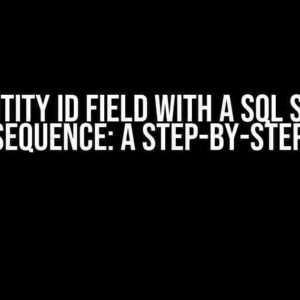Are you tired of encountering the dreaded “Unknown mappedBy” error when trying to set up a OneToOne relationship in your Java application? Do you find yourself scratching your head, wondering what’s going on behind the scenes? Fear not, dear developer, for we’re about to embark on a thrilling adventure to demystify this cryptic error and emergence victorious with a solid understanding of OneToOne relationships.
What is a OneToOne Relationship?
A OneToOne relationship is a type of entity relationship in Java where one instance of an entity is associated with only one instance of another entity. In other words, it’s a one-to-one mapping between two entities. This is in contrast to other types of relationships, such as OneToMany or ManyToMany, which allow for multiple associations.
The Anatomy of a OneToOne Relationship
A OneToOne relationship typically involves two entities: the owner and the target. The owner is the entity that owns the relationship, while the target is the entity being referenced. In a OneToOne relationship, the owner has a single reference to the target, and the target has a single reference back to the owner.
For example, consider a
Userentity with a OneToOne relationship to anAddressentity:public class User { @Id private Long id; private String name; @OneToOne(mappedBy = "user") private Address address; // getters and setters } public class Address { @Id private Long id; private String street; private String city; @OneToOne @JoinColumn(name = "user_id") private User user; // getters and setters }The Mysterious Case of Unknown mappedBy
Now, let's dive into the meat of the matter: the "Unknown mappedBy" error. This error occurs when the JPA provider (Java Persistence API) can't determine the owning side of the OneToOne relationship.
The culprit behind this error is often the `mappedBy` attribute, which specifies the field in the target entity that owns the relationship. When the `mappedBy` attribute is missing or incorrect, the JPA provider gets confused and throws the "Unknown mappedBy" error.
Symptoms of the Unknown mappedBy Error
If you're encountering the "Unknown mappedBy" error, you might see the following symptoms:
- The application fails to start or deploy
- Error messages mention "Unknown mappedBy" or " Unable to find mappedBy "
- The relationship between the entities is not established
Solving the Unknown mappedBy Error
Don't worry, dear developer, for we're about to dissect the "Unknown mappedBy" error and provide you with a step-by-step guide to resolve it.
Step 1: Identify the Owner and Target Entities
Determine which entity is the owner and which is the target in your OneToOne relationship. In the example above, the User entity is the owner, and the Address entity is the target.
Step 2: Specify the mappedBy Attribute
In the owner entity, add the `mappedBy` attribute to the `@OneToOne` annotation, pointing to the field in the target entity that owns the relationship. In our example, this would be:
public class User {
// ...
@OneToOne(mappedBy = "user")
private Address address;
// ...
}
Make sure the `mappedBy` attribute matches the name of the field in the target entity that references the owner entity.
Step 3: Verify the JoinColumn Annotation
In the target entity, ensure the `@JoinColumn` annotation is present and correctly configured. This annotation specifies the column in the target entity that references the owner entity. In our example:
public class Address {
// ...
@OneToOne
@JoinColumn(name = "user_id")
private User user;
// ...
}
Verify that the `name` attribute of the `@JoinColumn` annotation matches the column name in the database that references the owner entity's primary key.
Step 4: Review Entity Relationships
Double-check that the relationships between the entities are correctly established. Ensure that the owner entity has a reference to the target entity, and the target entity has a reference back to the owner entity.
Common Pitfalls and Troubleshooting Tips
As you venture into the world of OneToOne relationships, keep the following pitfalls and tips in mind:
- Remember that the `mappedBy` attribute only needs to be specified on the owner entity.
- Verify that the `@JoinColumn` annotation is present on the target entity, and its `name` attribute matches the column name in the database.
- If you're using a bidirectional relationship, ensure that the relationships are correctly established in both directions.
- Check for typos and incorrect field names in the `mappedBy` and `@JoinColumn` annotations.
Conclusion
And there you have it, dear developer! With these steps and tips, you should be well on your way to resolving the "Unknown mappedBy" error and establishing a solid OneToOne relationship in your Java application. Remember to stay vigilant and keep those relationships in check, lest you fall prey to the mysterious case of the unknown mappedBy.
| Entity | Relationship | Annotation |
|---|---|---|
| User (Owner) | OneToOne | @OneToOne(mappedBy = "user") |
| Address (Target) | OneToOne | @OneToOne @JoinColumn(name = "user_id") |
Now, go forth and conquer the world of Java relationships!
Frequently Asked Question
Get clarity on the often perplexing topic of OneToOne relationships with unknown mappedBy!
What is the purpose of the mappedBy attribute in a OneToOne relationship?
The mappedBy attribute in a OneToOne relationship specifies the field in the target entity that owns the relationship. It's like a map that guides the ORM to the correct column in the other table, ensuring a smooth and efficient data retrieval process.
What happens when I omit the mappedBy attribute in a OneToOne relationship?
Oh no! Leaving out the mappedBy attribute can lead to confusion and errors. The ORM won't know which column to use for the relationship, and you might end up with duplicate joins or incorrect data. So, always specify the mappedBy attribute to avoid these issues.
Can I use mappedBy with a composite primary key?
Yes, you can! When using a composite primary key, you need to specify the mappedBy attribute with the corresponding columns. This ensures the correct mapping between entities and prevents any chaos in your database.
How do I determine the correct mappedBy value for my OneToOne relationship?
To determine the correct mappedBy value, identify the field in the target entity that owns the relationship. Look for the column that uniquely identifies the related entity, and use that column name as the mappedBy value. If you're still unsure, consult your database schema and entity definitions.
What are the consequences of specifying an incorrect mappedBy value?
Oh dear! An incorrect mappedBy value can lead to errors, inconsistencies, and even data loss. The ORM might create incorrect joins, fetch wrong data, or throw exceptions. So, double-check your mappedBy value to ensure a smooth and accurate data retrieval process.


